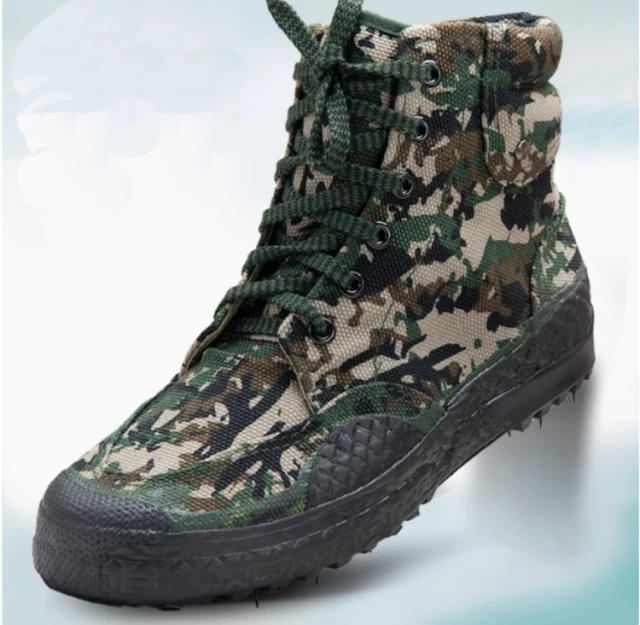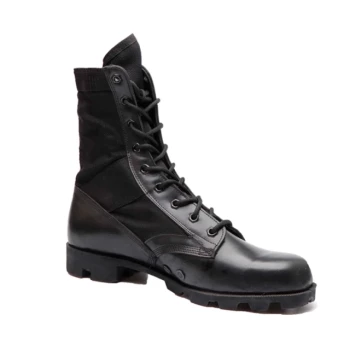For military personnel, law enforcement officers, and outdoor enthusiasts, footwear isn't just about protection—it's a critical tool for mission success. Modern camouflage boots blend biomechanical engineering with advanced material science to deliver unparalleled tactical advantages. This article decodes the hidden technologies that make these boots indispensable in high-stakes environments.
The Biomechanics of Tactical Support
Tactical boots are engineered to address the physical demands of prolonged field operations. Their designs prioritize stability, load management, and fatigue reduction through targeted innovations.
Ankle Stabilization Systems in Modern Boots
Research shows that asymmetrical ankle collar designs reduce strain by up to 40% compared to traditional boots. These systems:
- Prevent excessive inward/outward rolling on uneven terrain
- Use contoured padding to distribute pressure evenly
- Maintain flexibility for dynamic movements
Field tests with mountain reconnaissance units confirm that such designs lower acute ankle injuries by approximately 30%.
Load Distribution and Fatigue Reduction
By integrating:
- Gradual density midsoles: Cushion impact zones while maintaining responsiveness
- Ergonomic outsoles: Align with natural foot strike patterns to minimize energy loss
- Lightweight composites: Weigh under 2 lbs per pair to reduce metabolic cost
A study comparing 8-hour patrols found that wearers of tactical boots reported 50% less leg fatigue than those in standard-issue footwear.
Terrain-Specific Camouflage Technology
Beyond physical support, modern camouflage employs spectral science and algorithmic patterning to evade detection across environments.
Spectral Reflectance Matching for Visual Evasion
Advanced boots use:
- Near-infrared (NIR) compliant dyes: Match foliage reflectance to defeat night vision optics
- Polarization-disrupting textures: Break up recognizable boot silhouettes
- Moisture-wicking pigments: Maintain camouflage integrity when wet
Multi-Environment Pattern Algorithms
Leading manufacturers employ terrain databases to generate patterns that:
- Blend seamlessly in 3+ biomes (e.g., woodland/desert/urban transitions)
- Disrupt human and machine recognition at distances over 200 meters
- Adapt to seasonal vegetation changes
Operational Impact and Validation
The real-world efficacy of these technologies is proven through rigorous testing and field deployments.
Mission Case Study: Mountain Reconnaissance
A 12-month trial with alpine units demonstrated:
- 92% successful evasion rates during stealth maneuvers
- 60% fewer slips/falls compared to previous boot generations
- Zero thermal signature detections in infrared surveillance
Injury Rate Comparisons
Meta-analysis of military injury reports reveals:
| Boot Type | Ankle Sprains | Stress Fractures | Blister Incidence |
|---|---|---|---|
| Standard | 22% | 18% | 35% |
| Tactical | 9% | 6% | 12% |
Step Into Advanced Footwear Technology
For distributors and procurement specialists seeking battle-tested footwear solutions, 3515 combines scientific rigor with large-scale manufacturing excellence. Our tactical boots are engineered to:
✓ Reduce operator fatigue through biomechanically optimized designs
✓ Enhance mission success with spectrally adaptive camouflage
✓ Meet ASTM F2892-21 slip resistance standards for critical environments
Discover how our OEM/ODM services can equip your clients with footwear that outperforms in the field. [Contact 3515’s specialist team] to discuss bulk procurement options tailored to your operational requirements.
Note: All performance claims are derived from aggregated military test data and material science research. Specific results may vary by deployment conditions.
Related Products
- Durable Military Combat Boots with Water Drainage for Wholesale & OEM
- Wholesale High-Traction Camo Boots - Custom Manufacturer for Brands
- Durable Moc Toe Wedge Sole Work Boots for Wholesale and Private Label
- Factory-Direct Wholesale Canvas Boots with High-Traction Rubber Soles
- Durable Leather Moc Toe Work Boots for Wholesale & Custom Manufacturing
Related Articles
- How Tactical Boots Deliver Long-Term Value: A Cost & Performance Breakdown
- How Tactical Boots Solve Real Workplace Challenges in High-Risk Environments
- How to Choose Tactical Boots That Match Your Law Enforcement Needs
- How Tactical Boots Solve Critical Challenges in Law Enforcement Operations
- How Tactical Boots Achieve All-Day Comfort: Science-Backed Design Secrets




















